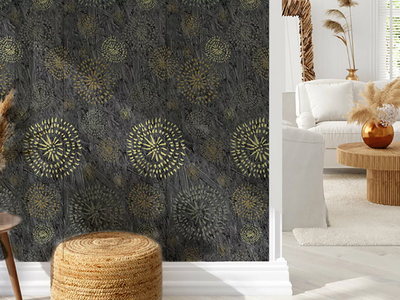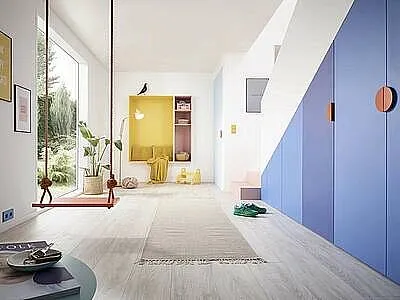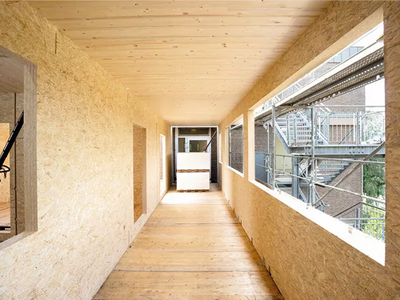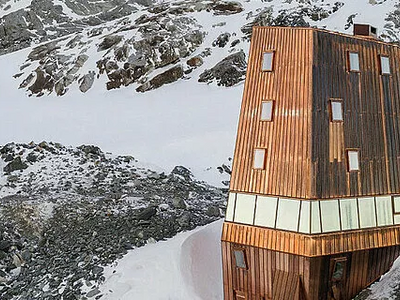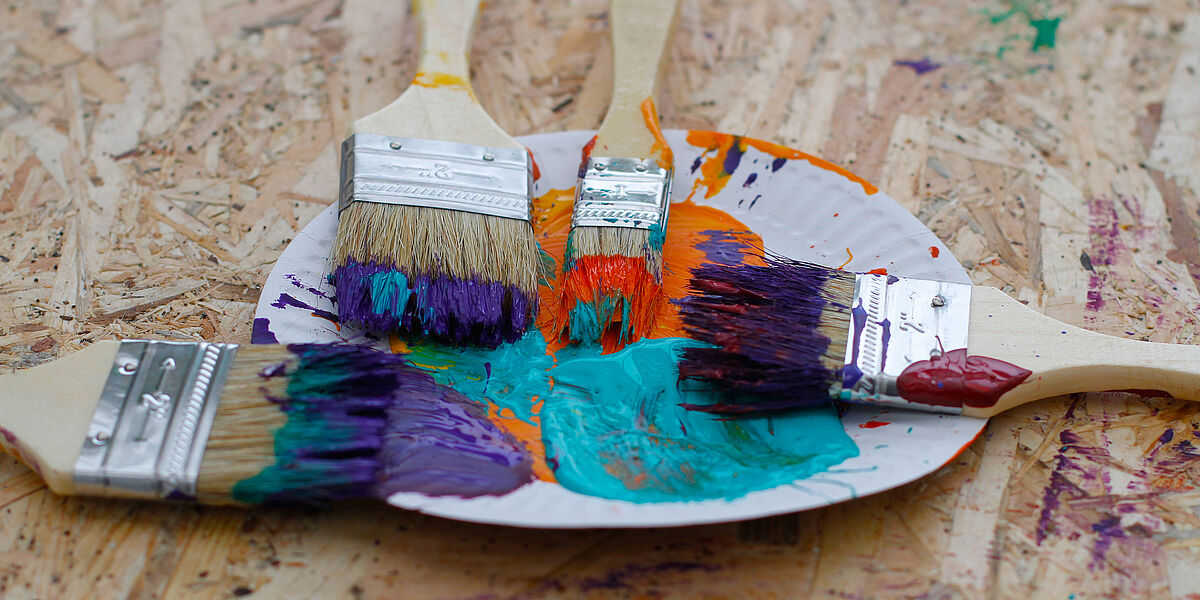Finishing OSB: Valuable Information for Users
Oriented strand board – commonly known as OSB – enjoys great popularity with self-builders, architects and the construction trades in Germany and many other countries. OSB boards are extremely versatile, excelling with superb technical properties and great value for money while lending themselves for a vast range of applications.
Owing to their striking, highly aesthetic surfaces, OSB boards are often installed where they are visible: for example, as prefinished floors or as wall and ceiling panels. They are also used to make furniture. More and more people who have new homes built insist on doing at least part of the work themselves, so if you are an architect or contractor you can advise your clients to directly finish OSB boards as a time- and cost-saving way of adding value.
OSB boards can definitely be directly finished with attractive results – but not all OSB is created equal! It depends. Is it sanded? Or does it have water- and moisture-repellent ContiFinish® surfaces?
ContiFinish® surfaces consist of a thin, compacted film of adhesive and wood resins which forms when strong pressure is applied by a ContiRoll® press from the company of Siempelkamp. It repels water and moisture, which makes the panels suitable for use on building exteriors and in moist rooms such as kitchens and bathrooms. Being extremely smooth, dense and non-absorbent, however, they are not necessarily the best choice for painting, varnishing and so on, however. If you nevertheless choose to do so, make sure to use only solvent-containing polyurethane- or synthetic resin-based products. Other coating systems only yield satisfactory results on sanded boards.
Virtually all coating products that can be used on solid wood can also be applied to sanded OSB. They include varnishes, oils, waxes and glazes, as well as water-based and natural paints. Multiple coats should be applied, sanding after the initial priming coat and possibly after the second as well. Similar to the grain of natural solid wood, the strands comprising the OSB tend to swell and stand up, resulting in an uneven surface. This is especially likely to happen with water-based coating products.
If, instead of painting the surface, you want to cover it with plaster, wallpaper or tiles, we strongly recommend that you only use our large-format boards for this, such as SWISS KRONO MAGNUMBOARD® OSB. Although it is theoretically possible to use smaller boards, there is a risk that over time the covering will develop cracks or even break over the joints between the boards. Special large-format boards, like those in which SWISS KRONO MAGNUMBOARD® OSB is available, permit storey-high, jointless constructions that allow problem-free direct covering or finishing.
Preparation and Acclimatisation
Before applying paint, varnish, oil or similar products, it is important to keep in mind that engineered wood products first have to be acclimatised. OSB boards are made from a natural raw material, and the larger wood strands in it tend to expand or shrink depending on the ambient moisture. If this happens after coating, it results in unsightly cracking or buckling. To prevent this, place the boards on top of small strips of wood, pallets or sawhorses at the site where they will be used. Always lay them horizontally; if you stack them, separate them with small spacers no more than 600mm apart. Never let them come into contact with the floor or ground and don’t let them get wet. If this is done correctly, the boards will gradually acclimate to their surroundings. It is recommended to wait 48 hours before proceeding.
Before applying paint, varnish etc. it is important to make sure that the boards are clean and free of dust and grease – especially if you have sanded them yourself before or after priming. The resulting dust is easy to remove by hoovering, brushing or sweeping and then wiping with a moist (not wet) cloth. Always wear a protective face mask while sanding.
After a clean board has been mounted on the wall, you paint or otherwise finish it. When using OSB as flooring, it is vital to choose a robust covering that will withstand soiling and wear. It is also advisable to seal the boards with a so-called barrier primer to prevent moisture penetration and seepage from the wood strands they contain, which might otherwise cause stains.
Painting OSB
Once boards have been acclimatised and installed, they can be coated with ordinary wall paint. Prior application of a barrier primer prevents the boards from absorbing excess water from the paint, which might otherwise cause them to warp or buckle. When using water-based paint, the strands on the surface can also swell slightly. If this happens, it’s necessary to sand and then apply an extra coat.
The best method for applying paint is to use a good-quality roller. Even less practised DIY enthusiasts can achieve a smooth, uniform surface this way.
Varnishing OSB
For OSB, we recommend that you use a solvent-based varnish. You can choose between high-gloss, matt and silky matt versions. Even special varnish for OSB boards is available. It’s important to apply it as thinly as possible. For lint-free results, it’s best to use a solvent-resistant synthetic-fibre roller. After each coat, sand the surface with fine-grained sandpaper and clean off the sanding dust before applying the next coat. Two or three coats are enough. If you are laying OSB to serve as flooring, it is a good idea to use a stain- and wear-resistant parquet or sealing varnish.
Staining and Glazing OSB
If you want to retain the characteristic look of OSB boards, you can stain or glaze them and then apply transparent protective varnish. As the individual strands absorb the colour of the applied stain or glaze differently, you wind up with a unique polychromatic result. The advantage of staining or glazing is that the surface structure of the boards remains visible while taking on a large palette of different hues or natural wood colours. Here too, sanding is essential. Applying more coats of stain will darken the surface. Stain deeply penetrates into the wood fibres, while glazes only colour them superficially. To protect the boards and obtain top-notch results, you should additionally apply a coat of protective varnish (after allowing the stain or glaze to dry). Alternatively, the surface can be sealed with oil or wax. Here too, be sure to use a good-quality brush or solvent-resistant synthetic-fibre roller.
Oiling and Waxing OSB
It’s also quite easy and straightforward to apply oil or wax. To achieve optimal results, sand the surface beforehand. The best way to apply these products is with a cloth or large, wide brush. One or two coats should be sufficient, and you can dispense with sanding. Especially for surfaces that won’t experience much wear and tear, it’s enough to simply apply the oil or wax. From the standpoint of building biology, linseed oil varnish or natural hard wax oil are unobjectionable. Small scratches are hardly noticeable on an oiled or waxed surface if you rub a bit more oil or wax into them.
Please careful with oil, though! It can occasionally provoke a chemical reaction with the natural resins contained in OSB. This can result in prolonged release of an unpleasant odour. We therefore recommend that you check with the oil’s manufacturer to make sure that it is suitable.
Papering OSB
As already mentioned above, wallpaper can be directly applied to special large-format OSB products like SWISS KRONO MAGNUMBOARD® OSB without any problems. These storey-high boards with lengths of up 18 metres can be used to create an entire wall without any joints. The boards’ surfaces are also sanded in the factory, which enhances their suitability for direct finishing. SWISS KRONO MAGNUMBOARD® OSB noticeably accelerates the pace of construction while reducing costs, as the additional step of covering it with other boards is eliminated.
We advise against directly papering small-format OSB boards, as the wallpaper can easily tear at any of the many joints between them. In this case, the best approach is to cover them first with gypsum plasterboard.
Plastering and Tiling OSB
The situation when plastering or tiling is similar to wallpapering: joints between boards can cause the plaster or tiles to crack or break. It is therefore necessary to first apply a layer of gypsum plasterboard. The best way to avoid problems to use special large-format OSB boards. In respect of costs, the extent of required work and the associated costs, the SWISS KRONO MAGNUMBOARD® OSB is more efficient and, due to its presanded surface, allows greater flexibility for finishing with plaster, wallpaper and tile.
To sum up the most important points:
- SWISS KRONO OSB with ContiFinish® surfaces can be coated with solvent-based PU (DD) or synthetic resin paint.
- Sanded surfaces are just as suitable as normal wood for coating with varnish, oil, wax, glaze etc.
- It is always advisable to apply multiple coats, sanding after each one.
- At least three coats are recommended.
- The only way to achieve an absolutely flat surface is by applying and smoothing filling compound.
- Direct application of plaster, tile or wallpaper is only recommended with large-format boards.
Did you know that …
…not all OSB boards look alike?
OSB is made from wood, a natural raw material that grows over a number of years, and its colour and microstructure can vary considerably depending on the site and region, the season in which the tree was felled and long-term weather conditions. Pinewood in particular often acquires a bluish tinge. However, and this is the good news, these differences in appearance have no effect whatsoever on the boards’ technical and functional properties. Every OSB board is unique, but SWISS KRONO OSB products are characterised by consistently excellent suitability for a wide range of uses.
Occasionally, shallow pockmarks occur on board surfaces. These are tiny defects caused by overlapping strands that cannot be removed by sanding. However, they are easy to conceal by filling them with a mixture of glue and OSB sanding dust or filling compound that is suitable for wood. In any case, they do not detract in any way from the boards’ performance. The only way to ensure an absolutely smooth surface is to apply filling compound.

